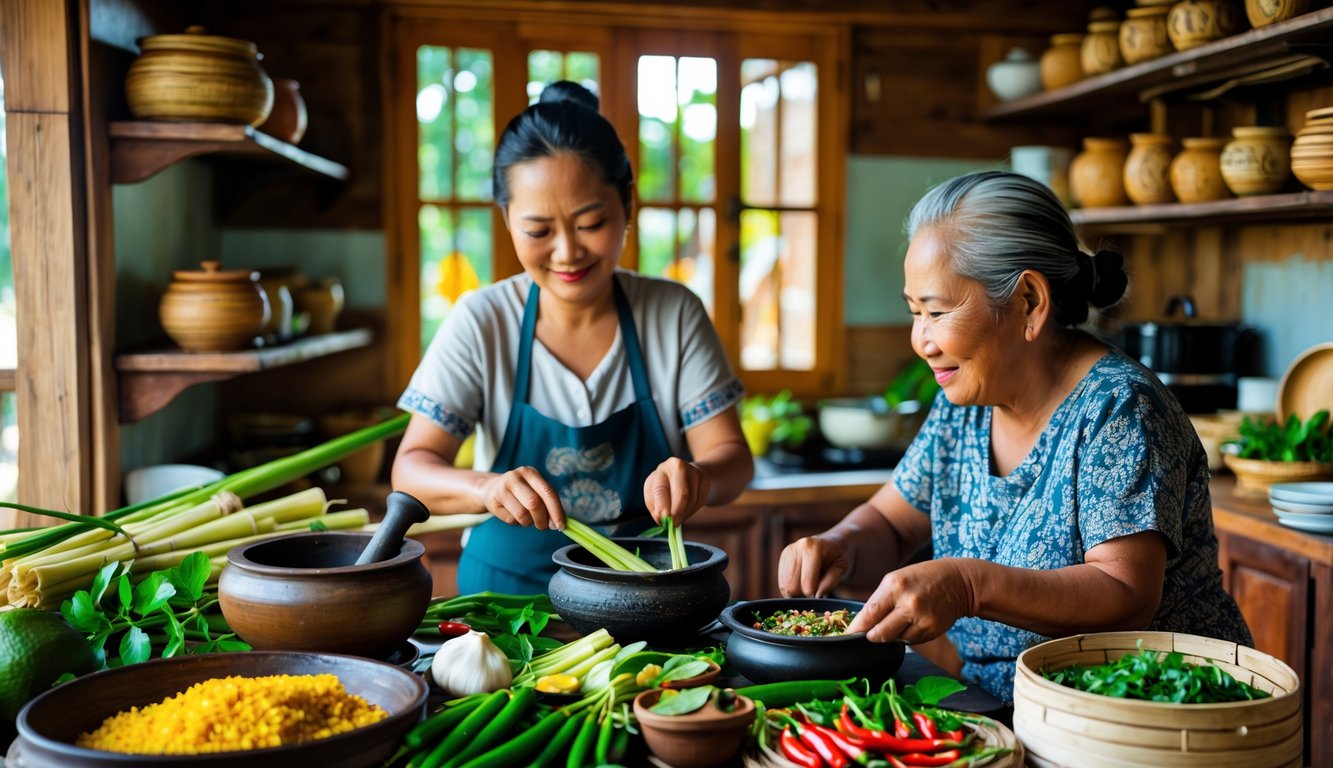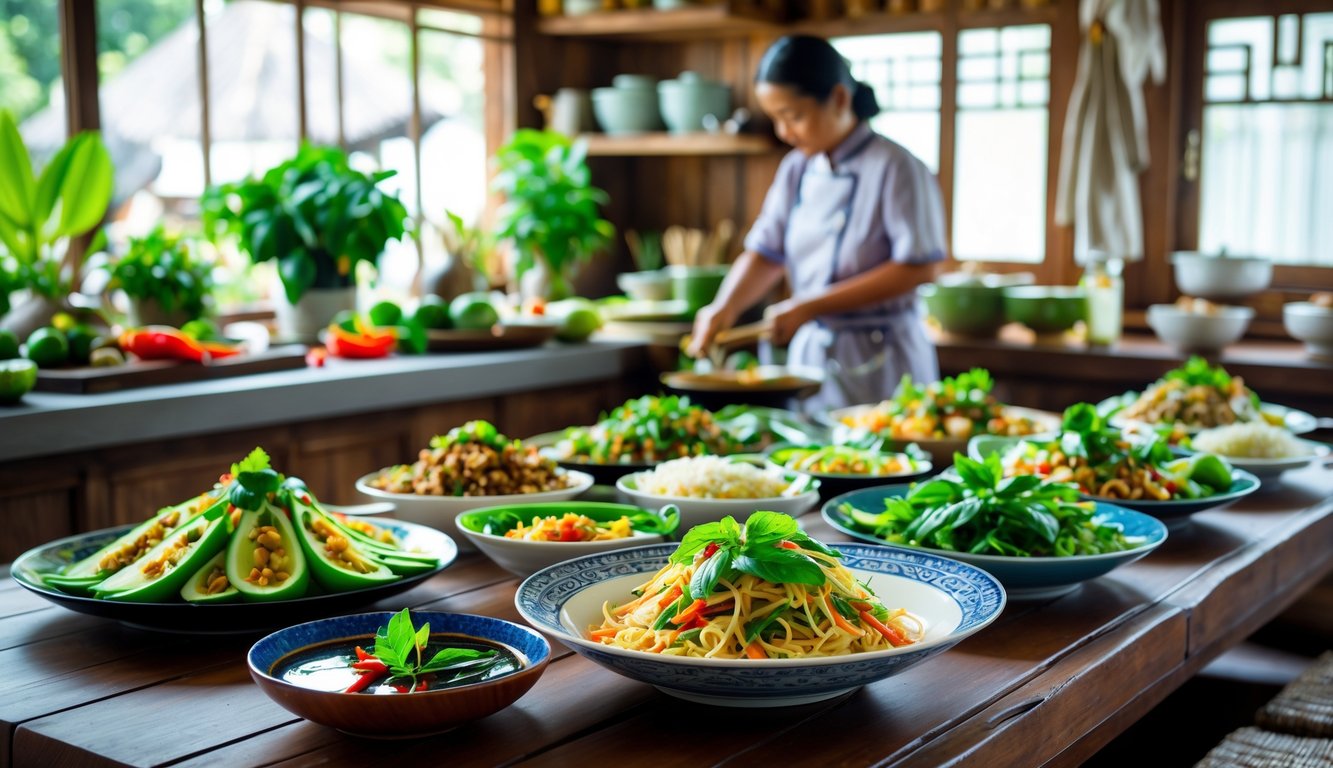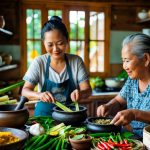
Timeless Thai Salads and Light Meals

Most Thai cooks swear they don’t mess with the old ways—rice noodles, shredded green papaya, real mint, bird’s eye chili, and never, ever carrots like they do in the West. I’m always thinking, does anyone actually whip up peanut dressing at home, or is that just a restaurant thing?
Thai Salad Traditions
Making real som tum is not cute for Instagram. It’s a workout. Grab a wooden mortar, pound green papaya, toss in raw garlic, fish sauce, lime, a pile of chili. Somehow, every market stall aunty nails the same ratio, but nobody agrees how sweet it should be (and yes, people argue about this).
Asked a Chiang Mai home cook if anyone swaps papaya for apple like some fusion joints in the West—she just laughed. Only tourists do that. Real som tum and yam salads? Fish sauce, spicy chilies, toasted rice powder, mint. Never parsley. And the raw yardlong beans and cabbage? Always there. Nobody skips the raw fixings.
Pad Thai Variations with Rice Noodles
Try telling a grandma in Ayutthaya to mess with Pad Thai and see what happens. No “zoodles,” no skipping the flat rice noodles, or you’re not invited back. Stir-fried in a big wok, tamarind sauce for tang, fish sauce for salt, palm sugar for that sticky thing, sometimes lime.
I watched a street vendor crank out hundreds of plates—she soaks the noodles ahead, not too soft, pre-mixes eggs with dried shrimp, says it’s her dad’s recipe. Chicken and tofu show up if there’s money, but ketchup? Never. I asked a friend who basically lived on pad thai in college—no, skipping rice noodles is not a thing in any Thai home.
Refreshing Garnishes and Dressings
Fresh herbs? Not optional. My aunt won’t serve salad without a pile of sweet Thai basil or mint leaves, just torn up. I’m kind of addicted to that “just picked” snap. Garnish isn’t just peanuts—sometimes it’s toasted rice, crispy shallots, lime wedge (always at the last second), but my niece once dumped fried garlic on by accident and, honestly, nobody cared.
Dressing isn’t just “pour and go.” Home cooks tinker: some swear by dark soy, others only want palm sugar for that smoky thing. Bottled peanut dressing? That’s new, and a Bangkok chef told me it kills the fresh flavors. The best dressings? Hand-mixed, fish sauce-heavy, spicy enough you keep adding sticky rice just to cool down.
Treasured Thai Desserts That Remain Unchanged
Honestly, these desserts aren’t trendy. Every kitchen I visited in Chiang Mai last year used the same battered steamer and old aluminum bowls. Nobody’s trying to “elevate” anything. Complexity? Try figuring out why sticky rice is always stickier when Aunt Mali makes it versus me.
Mango Sticky Rice
Somehow this one always gets dragged into “fusion” talk, but here it’s just khao niew mamuang—no microgreens, no variations. I watched three street vendors yell at a tourist for trying to swap coconut cream for almond milk—seriously, coconut milk is non-negotiable. Glutinous rice (low-amylose, if you care) gets soaked, steamed, and drenched in salted coconut cream—hot, not cold.
It’s always messy, odd little lumps. Locals say neat plating is just for tourists—grandmas just heap it up, slice Nam Dok Mai mangoes, seeds and all. No one weighs anything or Googles substitutions; they “just know”—which is both impressive and infuriating. Few ingredients, strict ratios, and honestly, it doesn’t need a makeover. Sweet, salty, creamy, messy. Done.
Thai Pumpkin Custard
First time I had sangkhaya fak thong, I figured it’d be too sweet. Nope. The custard—duck eggs (richer, more nutrients, see “Duck Egg Quality and Beta-Carotene Content in Thailand,” Journal of Food Biochemistry, 2022), palm sugar, coconut cream—gets poured into a hollowed-out pumpkin. Not those big Halloween ones, it’s kabocha squash, weird shapes and all.
Always served as orange-green slices, but any time someone claims a “shortcut” with ramekins, I check—locals don’t care. Nobody swaps palm sugar or cuts the fat (I asked: every home cook said, “Then it’s not Thai pumpkin custard”). The trick? Hand-beaten eggs, no electric mixers because “it froths wrong.” It never sets right outside a Thai kitchen—the texture is everything. Nobody swaps ingredients.
The Perfect Thai Iced Tea
What still drives me nuts: cha yen—Thai Iced Tea—never changes, no matter how many “modern updates” show up. Locals use “Number One Brand” or “ChaTraMue” tea. I tried others, always regretted it. Recipe? Brew it strong, dump in sugar, then both condensed and evaporated milk—yes, both.
Plastic cups, giant ice, rusty-orange swirl. Street sellers warn, “If it’s clear, throw it out.” Don’t bother with “deconstructed” versions; they’re confusing and never satisfying. Owner of a decades-old stand in Nakhon Pathom told me, “Change the milk, nobody comes back.” It’s about the tea leaves, but if you don’t scald it and serve it fast, someone will notice. Around here, it’s basically dessert in a glass. I still can’t get the ice to melt right at home.
Traditional Thai Home Cooking Techniques
None of this makes sense to my neighbor, a retired nutrition coach, who once told me, “Measuring chilies is for people who don’t pay rent.” Dishes get dumped and remixed, and nobody calls it inauthentic unless the fish sauce runs out or someone brings up cholesterol—then everyone just grabs sticky rice and moves on.
Balancing Flavors In Every Meal
So, four flavors: sweet, sour, salty, spicy. You think you know, but then my aunt skips palm sugar in tom yum because she saw something about prediabetes on TV. Totally off-balance. She says, “Real flavor’s about living, not lectures.” I’ve watched her toss in extra kaffir lime leaves, then call them “too judgmental” and fish them out—then forget a few. There’s always tension in Thai meals—everyone’s got an opinion on which flavor wins, and some people flip mid-bite depending on who’s looking.
Stats (Thai Health Survey, 2023) say most home cooks don’t use recipes—they trust their tongue. Nutrition advice sneaks in weirdly: cousin’s mother-in-law swaps fish sauce for low-sodium soy sometimes, but if the uncle visits, it’s double nam pla. Nothing’s written down. My own cheat? Extra tamarind pulp—grandma said it keeps joints from “rusting.” Is that true? Who knows.
Essential Kitchen Tools and Methods
If you’ve ever haggled for a carbon steel wok at Chatuchak, you get it: nothing else feels right. My first mortar and pestle cracked after three uses—granite’s worth it, ceramic is for people who want papaya salad “with no sound.” I’ve seen rice cookers banned from kitchens—“Steaming over muslin is the only way. Machines make it lonely,” my neighbor mumbles. Measuring spoons? Lost forever. “Guestimation” lives on.
My uncle grills chicken over coconut husks, swears the “smoke feeds the soul.” My brother’s all about high-heat stir-frying, claims gas flames wake up the herbs. Traditional methods shift: sometimes it’s a battered aluminum steamer, sometimes an electric blender hiding under grandma’s table. Nutrition coaches would hate the char from a street grill, but I can’t taste their advice, and neither can the cat, who jumps on the sticky table every night, never asking what made the meal “traditional.” Try pounding curry paste at 7am with a stone pestle and see how philosophical you feel when the neighbors start yelling.



